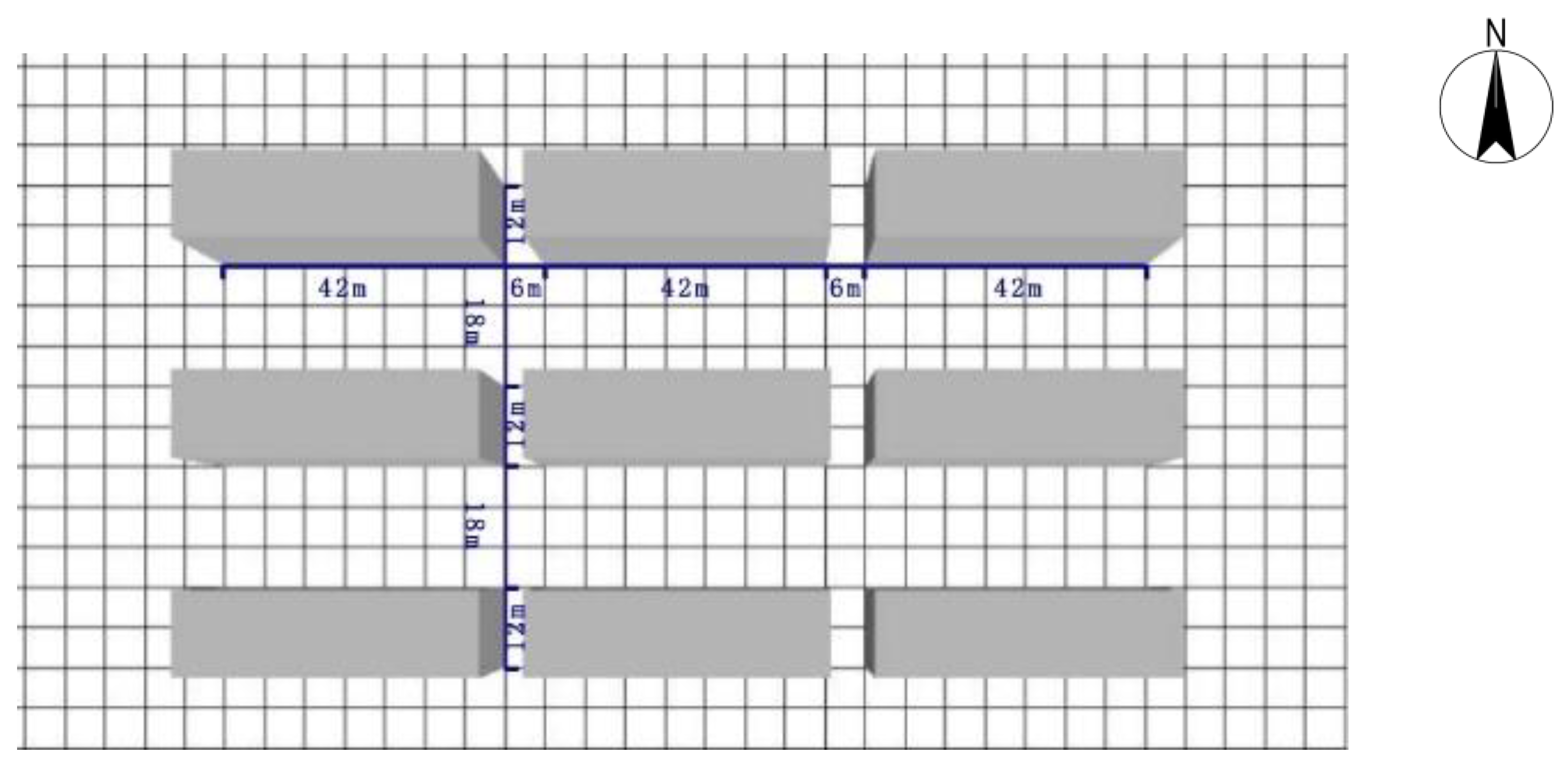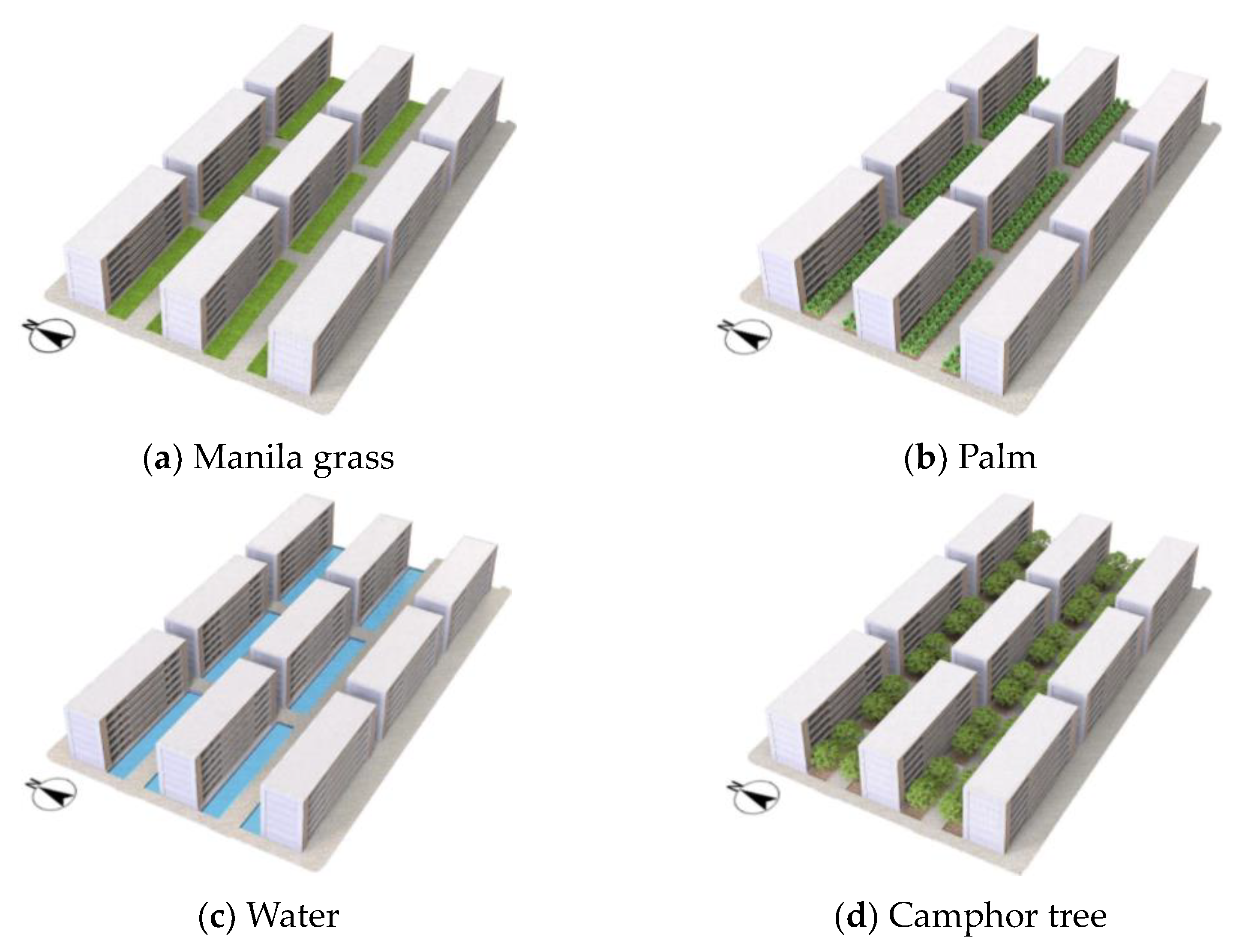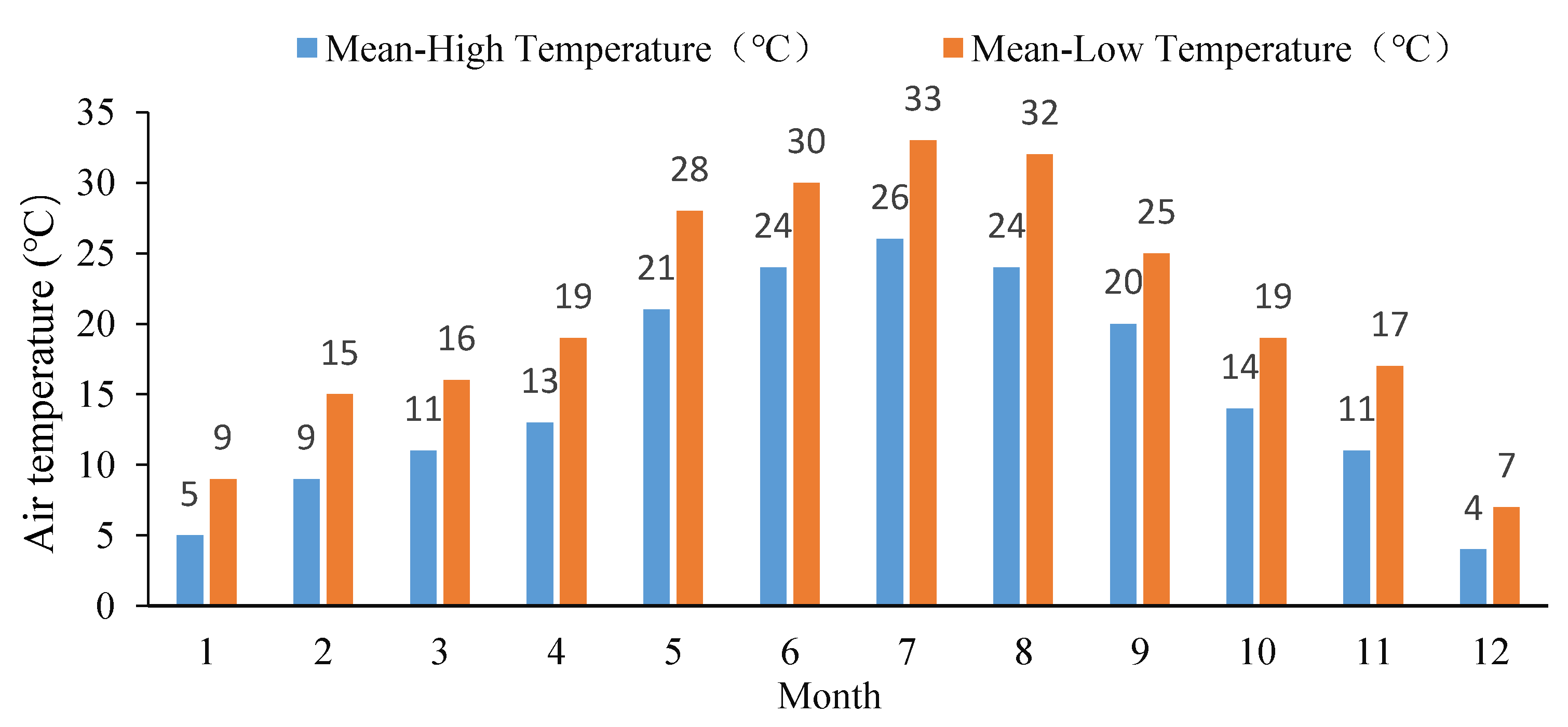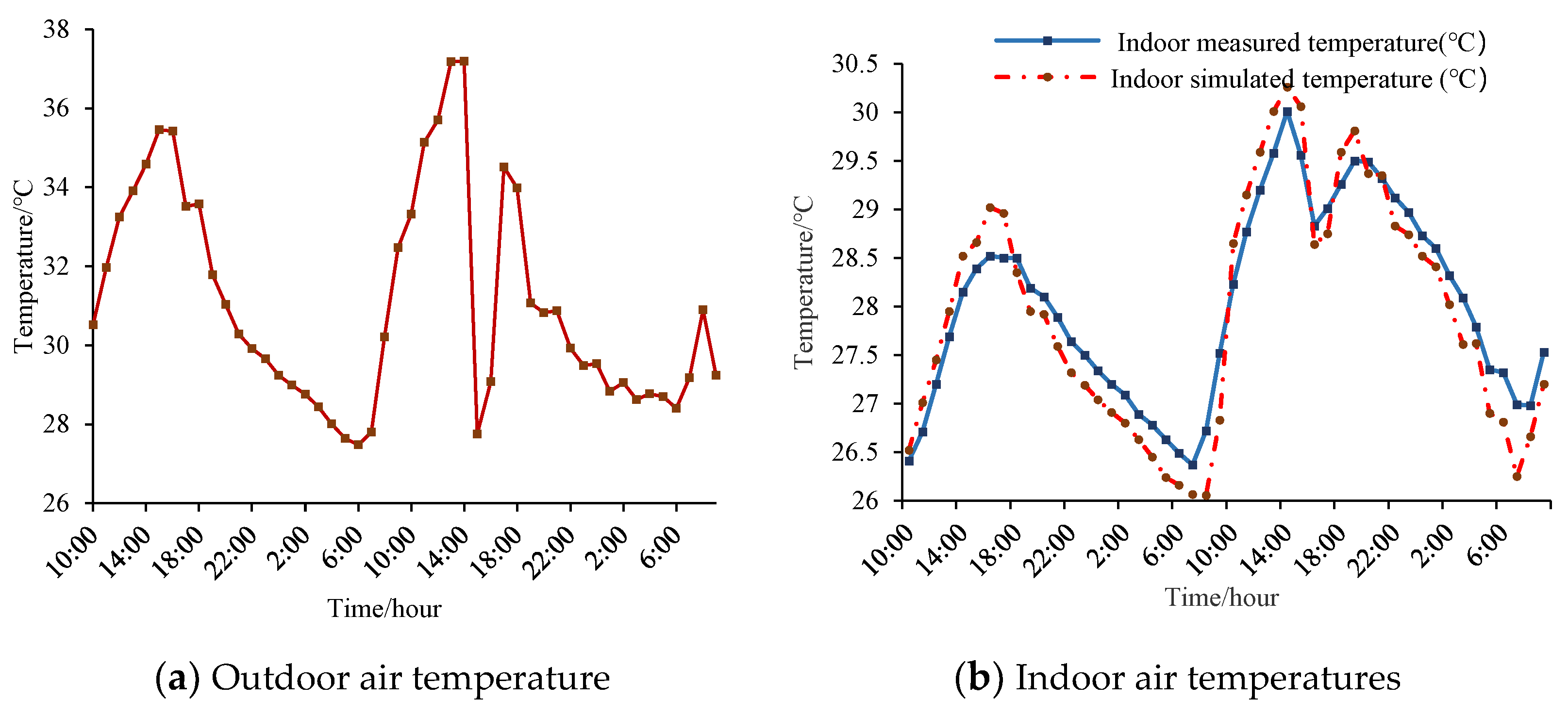The Annual Effect of Landscapes on the Indoor Thermal Environment in Residential Areas—A Case Study in Southern Hunan
Abstract
:1. Introduction
2. Materials and Methods
2.1. Residential Area in Southern Hunan
2.2. Research Scenario
2.3. Common Landscape Elements and Their Attributes
2.4. Climatic of Southern Hunan
2.5. Simulation Tool
3. Results and Discussion
4. Conclusions
Author Contributions
Funding
Data Availability Statement
Acknowledgments
Conflicts of Interest
References
- Lai, Y.; Tang, B.; Chen, X.; Zheng, X. Spatial determinants of land redevelopment in the urban renewal processes in Shenzhen, China. Land Use Policy 2021, 103, 105330. [Google Scholar] [CrossRef]
- Pozoukidou, G.; Chatziyiannaki, Z. 15-Minute City: Decomposing the new urban planning eutopia. Sustainability 2021, 13, 928. [Google Scholar] [CrossRef]
- Mundher, R.; Abu Bakar, S.; Maulan, S.; Mohd Yusof, M.J.; Al-Sharaa, A.; Aziz, A.; Gao, H. Aesthetic quality assessment of landscapes as a model for urban forest areas: A systematic literature review. Forests 2022, 13, 991. [Google Scholar] [CrossRef]
- Yin, J.; Bratman, G.N.; Browning, M.H.; Spengler, J.D.; Olvera-Alvarez, H.A. Stress recovery from virtual exposure to a brown (desert) environment versus a green environment. J. Environ. Psychol. 2022, 81, 101775. [Google Scholar] [CrossRef]
- Priya, U.K.; Senthil, R. A review of the impact of the green landscape interventions on the urban microclimate of tropical areas. Build. Environ. 2021, 205, 108190. [Google Scholar] [CrossRef]
- Wang, C.; Liang, W.; Yan, J.; Jin, Z.; Zhang, W.; Li, X. Effects of vegetation restoration on local microclimate on the Loess Plateau. J. Geogr. Sci. 2022, 32, 291–316. [Google Scholar] [CrossRef]
- Tan, X.; Liao, J.; Bedra, K.B.; Li, J. Evaluating the 3D cooling performances of different vegetation combinations in the urban area. J. Asian Archit. Build. Eng. 2022, 21, 1124–1136. [Google Scholar] [CrossRef]
- Li, J.; Zheng, B.; Ouyang, X.; Chen, X.; Bedra, K.B. Does shrub benefit the thermal comfort at pedestrian height in Singapore? Sustain. Cities Soc. 2021, 75, 103333. [Google Scholar] [CrossRef]
- Thani, S.S.O.; Mohamad, N.N.; Jamaludin, S.N. Outdoor thermal comfort: The effects of urban landscape morphology on microclimatic conditions in a hot-humid city. WIT Trans. Ecol. Environ. 2013, 179, 651–662. [Google Scholar]
- Hall, S.J.; Learned, J.; Ruddell, B.; Larson, K.L.; Cavender-Bares, J.; Bettez, N.; Groffman, P.M.; Grove, J.M.; Heffernan, J.B.; Hobbie, S.E. Convergence of microclimate in residential landscapes across diverse cities in the United States. Landsc. Ecol. 2016, 31, 101–117. [Google Scholar] [CrossRef]
- Lin, J.; Brown, R.D. Integrating microclimate into landscape architecture for outdoor thermal comfort: A systematic review. Land 2021, 10, 196. [Google Scholar] [CrossRef]
- Zhang, X.; Lei, Y.; Li, R.; Ackerman, A.; Guo, N.; Li, Y.; Yang, Q.; Liu, Y. Research on thermal comfort of underside of street tree based on LiDAR point cloud model. Forests 2022, 13, 1086. [Google Scholar] [CrossRef]
- Gatto, E.; Buccolieri, R.; Aarrevaara, E.; Ippolito, F.; Emmanuel, R.; Perronace, L.; Santiago, J.L. Impact of urban vegetation on outdoor thermal comfort: Comparison between a mediterranean city (Lecce, Italy) and a northern European city (Lahti, Finland). Forests 2020, 11, 228. [Google Scholar] [CrossRef]
- Sun, S.; Xu, X.; Lao, Z.; Liu, W.; Li, Z.; García, E.H.; He, L.; Zhu, J. Evaluating the impact of urban green space and landscape design parameters on thermal comfort in hot summer by numerical simulation. Build. Environ. 2017, 123, 277–288. [Google Scholar] [CrossRef]
- Feng, L.; Zhao, M.; Zhou, Y.; Zhu, L.; Tian, H. The seasonal and annual impacts of landscape patterns on the urban thermal comfort using Landsat. Ecol. Indic. 2020, 110, 105798. [Google Scholar] [CrossRef]
- Meili, N.; Acero, J.A.; Peleg, N.; Manoli, G.; Burlando, P.; Fatichi, S. Vegetation cover and plant-trait effects on outdoor thermal comfort in a tropical city. Build. Environ. 2021, 195, 107733. [Google Scholar] [CrossRef]
- Altunkasa, C.; Uslu, C. Use of outdoor microclimate simulation maps for a planting design to improve thermal comfort. Sustain. Cities Soc. 2020, 57, 102137. [Google Scholar] [CrossRef]
- Fatnassi, H.; Bournet, P.E.; Boulard, T.; Roy, J.C.; Molina-Aiz, F.D.; Zaaboul, R. Use of computational fluid dynamic tools to model the coupling of plant canopy activity and climate in greenhouses and closed plant growth systems: A review. Biosyst. Eng. 2023, 230, 388–408. [Google Scholar] [CrossRef]
- Perini, K.; Chokhachian, A.; Dong, S.; Auer, T. Modeling and simulating urban outdoor comfort: Coupling ENVI-Met and TRNSYS by grasshopper. Energy Build. 2017, 152, 373–384. [Google Scholar] [CrossRef]
- Liu, Z.; Zheng, S.; Zhao, L. Evaluation of the ENVI-Met vegetation model of four common tree species in a subtropical hot-humid area. Atmosphere 2018, 9, 198. [Google Scholar] [CrossRef]
- Liu, Z.; Cheng, W.; Jim, C.Y.; Morakinyo, T.E.; Shi, Y.; Ng, E. Heat mitigation benefits of urban green and blue infrastructures: A systematic review of modeling techniques, validation and scenario simulation in ENVI-met V4. Build. Environ. 2021, 200, 107939. [Google Scholar] [CrossRef]
- Tong, S.; Wong, N.H.; Tan, C.L.; Jusuf, S.K.; Ignatius, M.; Tan, E. Impact of urban morphology on microclimate and thermal comfort in northern China. Sol. Energy 2017, 155, 212–223. [Google Scholar] [CrossRef]
- Lehoczky, A.; Sobrino, J.A.; Skoković, D.; Aguilar, E. The urban heat island effect in the city of Valencia: A case study for hot summer days. Urban Sci. 2017, 1, 9. [Google Scholar] [CrossRef]
- Jin, H.; Cui, P.; Wong, N.H.; Ignatius, M. Assessing the effects of urban morphology parameters on microclimate in Singapore to control the urban heat island effect. Sustainability 2018, 10, 206. [Google Scholar] [CrossRef]
- Shi, L.; Luo, Z.; Matthews, W.; Wang, Z.; Li, Y.; Liu, J. Impacts of urban microclimate on summertime sensible and latent energy demand for cooling in residential buildings of Hong Kong. Energy 2019, 189, 116208. [Google Scholar] [CrossRef]
- Aflaki, A.; Mirnezhad, M.; Ghaffarianhoseini, A.; Ghaffarianhoseini, A.; Omrany, H.; Wang, Z.-H.; Akbari, H. Urban heat island mitigation strategies: A state-of-the-art review on Kuala Lumpur, Singapore and Hong Kong. Cities 2017, 62, 131–145. [Google Scholar] [CrossRef]
- Cheung, P.K.; Jim, C.Y. Effects of urban and landscape elements on air temperature in a high-density subtropical city. Build. Environ. 2019, 164, 106362. [Google Scholar] [CrossRef]
- Li, J.; Zheng, B.; Chen, X.; Zhou, Y.; Rao, J.; Bedra, K.B. Research on annual thermal environment of non-hvac building regulated by window-to-wall ratio in a Chinese city (Chenzhou). Sustainability 2020, 12, 6637. [Google Scholar] [CrossRef]
- Macintyre, H.L.; Heaviside, C.; Cai, X.; Phalkey, R. The winter urban heat island: Impacts on cold-related mortality in a highly urbanized European region for present and future climate. Environ. Int. 2021, 154, 106530. [Google Scholar] [CrossRef] [PubMed]
- Wang, M.; He, G.; Zhang, Z.; Wang, G.; Zhang, Z.; Cao, X.; Wu, Z.; Liu, X. Comparison of spatial interpolation and regression analysis models for an estimation of monthly near surface air temperature in China. Remote Sens. 2017, 9, 1278. [Google Scholar] [CrossRef]
- Li, X.; Hui, E.C.; Chen, T.; Lang, W.; Guo, Y. From Habitat III to the new urbanization agenda in China: Seeing through the practices of the “three old renewals” in Guangzhou. Land Use Policy 2019, 81, 513–522. [Google Scholar] [CrossRef]
- Whittinghill, L.J.; Rowe, D.B.; Schutzki, R.; Cregg, B.M. Quantifying carbon sequestration of various green roof and ornamental landscape systems. Landsc. Urban Plan. 2014, 123, 41–48. [Google Scholar] [CrossRef]
- Liu, W.; Zuo, B.; Qu, C.; Ge, L.; Shen, Q. A reasonable distribution of natural landscape: Utilizing green space and water bodies to reduce residential building carbon emissions. Energy Build. 2022, 267, 112150. [Google Scholar] [CrossRef]
- He, Y.; Lin, E.S.; Zhang, W.; Tan, C.L.; Tan, P.Y.; Wong, N.H. Local microclimate above shrub and grass in tropical city: A case study in Singapore. Urban Clim. 2022, 43, 101142. [Google Scholar] [CrossRef]
- Teichmann, F.; Baumgartner, C.M.; Horvath, A.; Luisser, M.; Korjenic, A. Simulation of urban microclimate with uhiSolver: Software validation using simplified material data. Ecol. Process. 2021, 10, 67. [Google Scholar] [CrossRef]
- Bruse, M. ENVI-met 3.0: Updated model overview. Univ. Bochum. 2004, 3, 1–12. [Google Scholar]
- Li, J.; Zheng, B.; Bedra, K.B.; Li, Z.; Chen, X. Evaluating the effect of window-to-wall ratios on cooling-energy demand on a typical summer day. Int. J. Environ. Res. Public Health 2021, 18, 8411. [Google Scholar] [CrossRef]
- Szűcs, Á.; Gál, T.; Andrade, H. Comparison of measured and simulated Mean Radiant Temperature: Case study in Lisbon (Portugal). Finisterra 2014, 49, 95–111. [Google Scholar] [CrossRef]
- Samanta, S.; Pal, D.K.; Lohar, D.; Pal, B. Interpolation of climate variables and temperature modeling. Theor. Appl. Climatol. 2012, 107, 35–45. [Google Scholar] [CrossRef]
- Ozelkan, E.; Bagis, S.; Ozelkan, E.C.; Ustundag, B.B.; Yucel, M.; Ormeci, C. Spatial interpolation of climatic variables using land surface temperature and modified inverse distance weighting. Int. J. Remote Sens. 2015, 36, 1000–1025. [Google Scholar] [CrossRef]
- Li, J.; Zheng, B.; Chen, X.; Qi, Z.; Bedra, K.B.; Zheng, J.; Li, Z.; Liu, L. Study on a full-year improvement of indoor thermal comfort by different vertical greening patterns. J. Build. Eng. 2021, 35, 101969. [Google Scholar] [CrossRef]










| Concrete (Hollow Block) | Value |
| Absorption (Frac) | 0.50 |
| Transmission (Frac) | 0.00 |
| Reflection (Frac) | 0.50 |
| Emissivity (Frac) | 0.90 |
| Special Heat J/(kg∗K) | 1500.00 |
| Thermal Conductivity W/(m∗K) | 0.07 |
| Density (kg/m3) | 400.00 |
| Clear Float Glass | Value |
| Absorption (Frac) | 0.05 |
| Transmission (Frac) | 0.90 |
| Reflection (Frac) | 0.05 |
| Emissivity (Frac) | 0.90 |
| Special Heat J/(kg∗K) | 750.00 |
| Thermal Conductivity W/(m∗K) | 1.05 |
| Density (kg/m3) | 2500.00 |
| Manila Grass Parameters | Manila Grass Index |
| Height (cm) | 25.0 |
| Foliar type | grass |
| Reflectivity | 0.20 |
| Transmittance | 0.30 |
| Rhizome depth (cm) | 20 |
| Canopy leaf area index (LAD) | 0.3 |
| Root area index (RAD) | 0.1 |
| Palm Parameters | Palm Index |
| Height (m) | 3.0 |
| Width (m) | 3.0 |
| Foliar type | meristem foliage |
| Reflectivity of foliar shortwave radiation | 0.18 |
| Foliar shortwave transmittance | 0.3 |
| Foliar weight (g/m2) | 100.0 |
| Isoprene capacity | 12.0 |
| Rhizome depth (m) | 1.8 |
| Rhizome diameter (m) | 1.8 |
| Camphor Tree Parameters | Camphor Tree Index |
| Height(m) | 10 |
| Width (m) | 9 |
| Foliar type | meristem foliage |
| Reflectivity of foliar shortwave radiation | 0.60 |
| Foliar shortwave transmittance | 0.3 |
| Foliar weight (g/m2) | 100.0 |
| Isoprene capacity | 12.0 |
| Rhizome depth (m) | 4.0 |
| Rhizome diameter (m) | 10.0 |
| Water Body Parameters | Water Body Value |
| Depth (m) | 1.2 |
| Z0 roughness | 0.01 |
| Reflectivity | 0.0 |
| Emissivity | 0.96 |
Disclaimer/Publisher’s Note: The statements, opinions and data contained in all publications are solely those of the individual author(s) and contributor(s) and not of MDPI and/or the editor(s). MDPI and/or the editor(s) disclaim responsibility for any injury to people or property resulting from any ideas, methods, instructions or products referred to in the content. |
© 2024 by the authors. Licensee MDPI, Basel, Switzerland. This article is an open access article distributed under the terms and conditions of the Creative Commons Attribution (CC BY) license (https://creativecommons.org/licenses/by/4.0/).
Share and Cite
Li, J.; Zheng, B.; Chen, X.; Wang, L. The Annual Effect of Landscapes on the Indoor Thermal Environment in Residential Areas—A Case Study in Southern Hunan. Forests 2024, 15, 1099. https://doi.org/10.3390/f15071099
Li J, Zheng B, Chen X, Wang L. The Annual Effect of Landscapes on the Indoor Thermal Environment in Residential Areas—A Case Study in Southern Hunan. Forests. 2024; 15(7):1099. https://doi.org/10.3390/f15071099
Chicago/Turabian StyleLi, Jiayu, Bohong Zheng, Xiao Chen, and Lan Wang. 2024. "The Annual Effect of Landscapes on the Indoor Thermal Environment in Residential Areas—A Case Study in Southern Hunan" Forests 15, no. 7: 1099. https://doi.org/10.3390/f15071099






